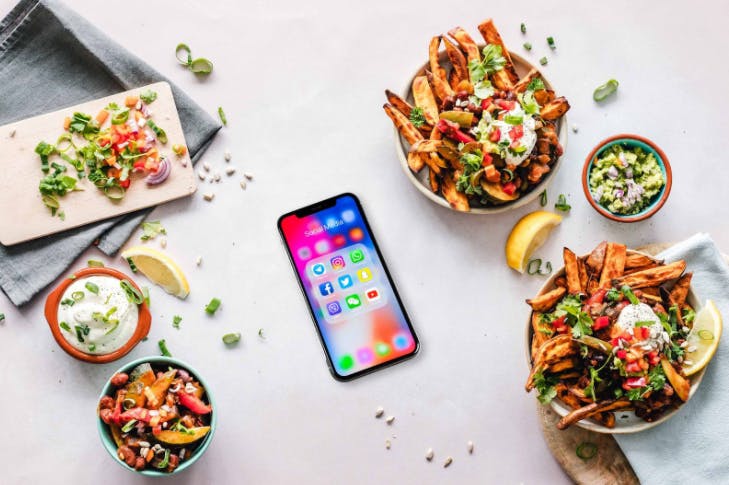

4. Keep it real! Showcase the faces behind your business
You’re already well aware that your people are one of your restaurant’s most important assets. They work hard to keep your customers happy, all while maintaining a smile. Using your social media as a look behind the curtain, or counter, is one way to ensure you come across as authentic, human, and relatable. Consider showcasing how your best-selling menu item is made & prepared in the kitchen, what the lunch rush looks like in your back of house, or how grateful you are to have a committed team who makes it all possible. Having a “prompt” or “theme” can keep your content fresh and inspired when creating staff-centric content. For example, what if you asked each one of your chefs what their favorite item on the menu is, or what modifiers make one of their favorite dishes even better? What if you asked your bartender what cocktail tastes best during which season? Keeping it real is a breath of fresh air that your potential customers appreciate in today’s filtered and edited world.
5.Create content that has something for users to do: a prompt to respond to, a contest/sweepstakes to enter, a promo to screenshot
Social media marketing for restaurants presents an excellent opportunity to let your customers/potential customers interact with your restaurant digitally. Making engaging content is a perfect way to extend the experience of your restaurant beyond your brick and mortar, and the best way to foster engagement on social media is to, well, give your followers something to engage with! You can execute this through promos– for instance, posting about a limited-time offer & prompting users to like, comment and screenshot to redeem the promotion. You can also create a sweepstake that encourages users to follow, like, comment, and share a post to be entered to win a year of free fries, a side of chips, or something equally enticing. If you’re looking to foster social engagement without a giveaway or promo, consider gamifying your content.

6. Incentivize the sharing of user-generated content (UGC)
Social media marketing for restaurants can take advantage of something restaurants have that many other industries don’t: happy customers. People love to feel recognized and appreciated. And when it comes to social media, this can happen through comments & likes, but also through sharing & reposts. Encourage customers to take pictures of their food and share their experience by giving them special discounts and promotions when they use a specific hashtag, add the location, or even tag your restaurant.This not only gives your restaurant authentic, diversified content to post, it also opens up a potential new audience to your restaurant! If the food looks great, the customer who posted it may create a sense of FOMO amongst their following – resulting in that person’s friend trying your restaurant!
7. Consider partnering with influential voices in your community to increase awareness of your restaurant
More and more people are turning to food influencers and social media for advice on where to eat, especially on social media. When it comes to trying the new restaurant next door, we tend to trust reviews and recommendations blindly. In fact, 92% of consumers say they trust the advice from their friends, relatives, and influencers more than any other form of advertising. Instagram created a strong foodie community due to its visual nature, and TikTok is becoming an influential source to let consumers experience your restaurant through short video content. However, we all know that it isn’t as simple as it sounds, and going “viral” feels more like a shot in the dark. So as more social media platforms emerge, it's becoming increasingly important that social media marketing for restaurants involves partnering with influential people in your community to reach a larger audience quickly and effectively. These may be TikTokers, YouTube creators, food bloggers, Instagrammers, Facebook users, or Twitter users. Don’t know where to start? The first step is to create a budget and determine which platform your target audience uses the most. Now focus on finding a local that enjoys eating the food you serve with the correct following you are looking to reach.

8. Make sure to stay up to date with social media strategies like alt text, hashtags, and the algorithm
Here is where things get tricky, and as intimidating as the algorithms sound, you CAN beat them and benefit from them. So allow us to demystify the confusing world of social media algorithms. It’s as simple as providing specific information to the platform, so it is easier for users to find your restaurant and engage with your content. A simple strategy to boost your social media presence is to make sure your images have been described in the alternative text boxes on all channels, ensuring that videos have readable subtitles, and doing detailed research on hashtags. Another practice to start implementing consistent posting. Erratic posting may sometimes lead to engagement drop, so focusing on persistence will help you build a more substantial follower base.
9. Celebrate holidays, internet holidays and cultural moments on your restaurant’s social channels to incentivize engagement
When it comes to social media marketing for restaurants, it’s crucial to build a content calendar that includes all essential dates and provide relevant information. There are infinite days your restaurant can celebrate, as today, there’s pretty much a holiday for any food or anything you can think of. Don’t believe us? Well, considering that national zipper day and hug your cat day exist, there are truly infinite reasons to celebrate. Beyond scheduling holiday-centric content in advance, make sure you’re engaging and connecting with your customers rather than just using a strange holiday to make random content. Some people tend to steer away from this type of content because if executed incorrectly, it doesn’t drive much value. However, it’s a huge opportunity to create valuable content as these special dates usually have a strong emotional connection to most users. So instead of sticking to the usual “Happy National Pizza Day!” post, use the holiday as a prompt to spark new ideas and create fun, unique, and dynamic content. Think about promos or specials your restaurant can offer that day, and create content to increase awareness of that offer. Here is a food holiday calendar so you'll never miss a day worth celebrating!
10. Share updates, new menu items, and other restaurant news to your social stories
Real time-marketing has become more exciting over the years, especially when it comes to social media marketing for restaurants. In the age of Snapchat, Twitter, and Instagram stories, we want to be up-to-date with everything and be notified when anything changes. Sharing updates around new menu items and special events is a great way to incentivize people to order from your restaurant or even schedule a reservation immediately. You could even market a new item release in a way that will increase engagement across all platforms. For example, making your audience guess the new item before it releases, sharing the story of what inspired the new dish, and documenting the process are all fun ways to promote your restaurant and excite older clients.









Social media marketing for restaurants
Gone are the days when print advertising, food quality, and in-store ambiance were the only touch points of your restaurant’s brand. In 2022, how people perceive your restaurant’s brand relies on, yes, food quality, advertising & in-store ambiance, but also reviews, delivery speed, and your social media presence. We know that as a busy restaurant operator, tasks like inventory management, staffing, scheduling, and balancing books likely take precedence over social media, but done right, social media marketing for restaurants can boost your brand perception, sales, and customer loyalty. Hard to believe? Let’s take a look at the data.
Based on the above, it’s critical that your restaurant maintains an active presence on social channels, creates engaging content that users want to interact with, and manages communication with your followers (or potential customers) regularly. Today, we’ll cover how you can create engaging content for your restaurant’s social media channels.